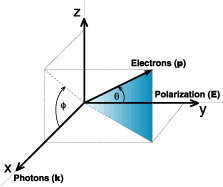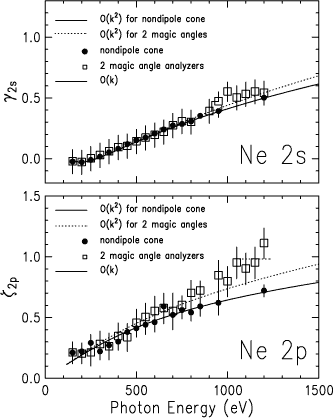
More Trouble for the Dipole Approximation
A multi-institutional collaboration comprising both theorists and experimentalists working at the ALS has made the first measurements of second-order nondipole effects in the angular dependence of the cross section for neon valence photoemission. The finding potentially applies to a wide variety of x-ray photoemission studies, including gas-phase, surface-science, and materials-science work, where researchers may now need to account for the influence of higher-order nondipole terms beyond the standard dipole approximation conventionally applied to the interaction of x rays with matter.
|
Expanded
as a series, the exponential factor describing the x-ray radiation
field at the absorbing atom or molecule has the form where k is the x-ray wave vector (2p/l) and O(kn) comprises terms proportional to the nth power of k. The dipole (or electric dipole) approximation refers to keeping only the 1, so it is also the zeroth-order approximation. Within the dipole approximation, the differential cross section (cross section per unit solid angle) for angle-resolved photoemission with linearly polarized x rays is described by three quantities: the partial cross section, s(hn), the angular-distribution parameter, b(hn), and the angle (q) of the photoelectron trajectory relative to the polarization vector. When extracted from angular distribution measurements, s(hn) and b(hn) provide information about the electronic structure of the atom and the molecule and the dynamics of the photoionization process. For example, at the "magic angle" q = 54.7º, the angular term disappears and s(hn) is obtained. 
|
Finding the Devil in the Details
|
|
It has long been known that this approximation is not valid for high photon energies (e.g., above 5 keV), where the photon wavelength is smaller than the size of the atom or molecule. In the last few years, groups working at the ALS and elsewhere have shown that additional first-order nondipole (specifically, electric quadrupole) terms are needed in the rare gases at lower photon energies and close to an ionization threshold. These terms involve two first-order energy-dependent parameters, d(hn) and g(hn), and a new angle variable (f). At this level of approximation, the recent rare-gas experiments showed significant modifications of the photoelectron angular distributions compared to those expected within the dipole approximation, modifications that were in generally good agreement with the first-order calculations. However, when conducting the analysis for neon in terms of the g(hn) for 2s photoemission and z(hn) (where z = 3d + g) for 2p photoemission, experimenters at the ALS noticed that some discrepancy remained, particularly for neon 2p photoemission. Theorists among the group calculated a general expression for the angle-resolved photoemission cross section including second-order contributions, which introduced four new energy-dependent nondipole factors dominated by electric-octupole and pure electric-quadrupole effects. Since no new angles were involved, the second-order corrections could then be recast in terms of effective values of g(hn) and z(hn) for comparison with their measurements on neon. The group made this comparison for four geometries, two with q at the magic angle where only nondipole terms are important, and two on a "nondipole cone" at an angle of 35.3º around the direction of the x-ray beam. Comparison of experiment with first-order theory yielded good agreement for both neon 2s and 2p photoemission for detectors on the nondipole cone, but in the magic-angle geometry, second-order corrections were needed, especially for neon 2p.

The complex angular dependence of the differential cross section means that which corrections to the dipole approximation are needed depends on the experimental geometry, but the new results demonstrate that researchers need to be ready to include nondipole effects through at least the second order in analyzing their results. Research conducted by A. Derevianko and W.R. Johnson (University of Notre Dame); O. Hemmers, S. Oblad, and D.W. Lindle (University of Nevada, Las Vegas); P. Glans (Stockholm University); H. Wang (Uppsala University); S.B. Whitfield (University of Wisconsin); R. Wehlitz (University of Wisconsin); and I.A. Sellin (University of Tennessee, Knoxville). Research funding: National Science Foundation, EPSCoR Program of the U.S. Department of Energy, and University of Nevada, Las Vegas. Operation of the ALS is supported by the Office of Basic Energy Sciences, U.S. Department of Energy. Publication about this experiment: A. Derevianko, O. Hemmers, S. Oblad, P. Glans, H. Wang, S.B.Whitfield, R. Wehlitz, I.A. Sellin, W.R. Johnson, and D.W. Lindle, "Electric-Octupole and Pure-Electric-Quadrupole Effects in Soft-X-Ray Photoemission," Phys. Rev. Lett. 84, 2116 (2000).
|
||
More ALS Science